実施日 : 2023年04月25日(火) - 26日(水)
Pre-G7 Summit Hiroshima Press Tour
投稿日 : 2023年04月04日
[Tour Topic]
Passing down the Legacy of Peace in Hiroshima, from Reconstruction to the Future
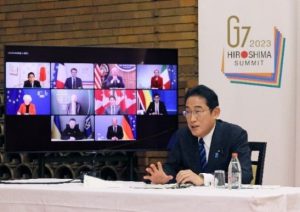
[Source: Prime Minister’s Office of Japan website]
On May 23, 2022, at a press conference after the Japan-US summit meeting, Prime Minister Kishida announced that Japan would hold the G7 presidency in 2023, and the G7 Summit would be held in Hiroshima, stating, “it to be best suited for the G7 to demonstrate our commitment to peace,” and “to demonstrate to the world our pledge for humankind never to repeat the devastation of using nuclear weapons.”
The G7 Summit will be held in Hiroshima from May 19 to 21, 2023. This press tour will take place in Hiroshima one month before the summit. This tour is sponsored by the Citizens Council for the Hiroshima Summit, which was founded by local community to support the G7 Summit, and is co-sponsored by the Ministry of Foreign Affairs. The Citizens Council for the Hiroshima Summit is a joint public-private organization consisting of Hiroshima Prefecture, the City of Hiroshima, and related organizations in various fields, such as the economy, transportation, and medical care, and is implementing prefecture-wide initiatives based on five pillars: “Supporting the holding of the Summit,” “Hospitality,” “Disseminating information about peace,” “Communicating the appeal of Hiroshima,” and “Promoting youth participation in events leading to post-summit activities.”
This tour will visit Hiroshima ahead of the G7 Summit, listening to locals’ voices on the summit as well as covering the realities of the atomic bombing, the hope of atomic bomb survivors for peace, the history of reconstruction by companies and their current state, and efforts of young people who are carrying on their hopes.
[Tour Details]
1. Companies and the History of Reconstruction
(1) Hiroshima Electric Railway Co., Ltd.
-Living witnesses still running to this day, streetcars that survived the atomic bombing
On August 6, 1945, the city of Hiroshima was destroyed by an atomic bomb. The streetcars that have become a symbol of Hiroshima today were also devastated, with all lines out of service. However, only three days after the bombing, operations resumed through people’s tireless efforts, and many streetcars that were damaged in the bombing were repaired once again as a means of transporting local residents. Many residents are encouraged and inspired by the streetcars powerfully running through their city which had been turned to rubble.
These streetcars became known as “hibaku densha” (atomic-bombed streetcars), and supported Hiroshima as it began reconstruction. Three streetcars still support the lives of the people of Hiroshima today.
This tour will be able to film and photograph the atomic-bombed streetcars which provide transportation to the people of Hiroshima. The tour will then hear about the history of Hiroshima Electric Railway and the reconstruction. The tour will also head to the Senda Depot to cover the atomic-bombed streetcar which are stored there and the G7-wrapped streetcar designed by high school students in the prefecture.
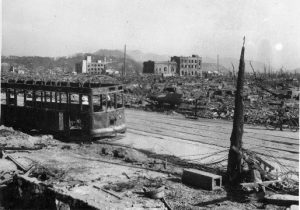 [Photo by Mr. KAWAHARA Yotsugi, courtesy of the Hiroshima Peace Memorial Museum] |
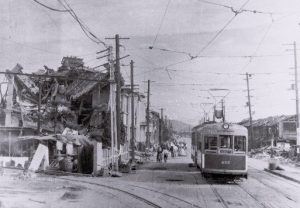 [Photo by Mr. KAWAHARA Toshio, courtesy of Mr. KAWAMOTO Yoshio] |
 |
 |
[Photos courtesy of Hiroshima Electric Railway Co., Ltd.]
-Making wooden future recognized around the world for its quality after 100 years
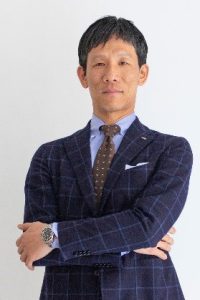 Since its establishment in 1928, Maruni Wood Industry was well-regarded around the world as a manufacturer of wooden furniture. In order to deliver quality products to more people at a fair price, based on the motto of “industrializing craftsmanship,” Maruni has established woodworking processing technology, which was an extremely difficult skill to master, and made furniture for daily lives under the division of labor between artisans and machines.
Since its establishment in 1928, Maruni Wood Industry was well-regarded around the world as a manufacturer of wooden furniture. In order to deliver quality products to more people at a fair price, based on the motto of “industrializing craftsmanship,” Maruni has established woodworking processing technology, which was an extremely difficult skill to master, and made furniture for daily lives under the division of labor between artisans and machines.
Maruni was designated as a military factory before and during World War II, producing many military goods, and in 2008 it began sales of its most well-known product, the Hiroshima Armchair. This chair, with its beautiful design and high functionality, is used by top companies and luxury hotels around the world, including the head office of Apple, the Pier One Sydney Harbour hotel in Australia, and Blue Bottle Coffee. Along with the chair, the name of the City of Peace, Hiroshima, is being disseminated around the world.
This tour will visit the head office of Maruni Wood Industry, located in the mountains on the outskirts of Hiroshima City, hear from Chairman YAMANAKA Takeshi about the company’s history after WWII, the Hiroshima Armchair that is popular around the world, and sales they have made around the world. The tour will then see the manufacturing process for the Hiroshima Armchair, including the materials used, how parts are processed, and how it is put together.
 |
 |
[Photos courtesy of Maruni Wood Industry]
(3) Orizuru Tower/Companies in Hiroshima Prefecture
-Local companies, reconstruction, and hopes for the future
 Hiroshima Mazda was established in 1933, near the present-day Atomic Bomb Dome, and in 1945 all the employees were killed in the atomic bomb. The company’s main business is selling cars, but in 2016 it opened the Orizuru Tower. It is a multipurpose space with a variety of installations, including the Orizuru Wall made of wishes for peace, and the Hiroshima Hills observation deck with a view of the Atomic Bomb Dome and the city of Hiroshima. The open-air observation deck has no windows, allowing visitors to experience the breezes of Hiroshima. Orizuru Tower was built with the hope with the hope that visitors from the world will come to see the reconstructed Hiroshima, so pamphlets are available in 17 languages.
Hiroshima Mazda was established in 1933, near the present-day Atomic Bomb Dome, and in 1945 all the employees were killed in the atomic bomb. The company’s main business is selling cars, but in 2016 it opened the Orizuru Tower. It is a multipurpose space with a variety of installations, including the Orizuru Wall made of wishes for peace, and the Hiroshima Hills observation deck with a view of the Atomic Bomb Dome and the city of Hiroshima. The open-air observation deck has no windows, allowing visitors to experience the breezes of Hiroshima. Orizuru Tower was built with the hope with the hope that visitors from the world will come to see the reconstructed Hiroshima, so pamphlets are available in 17 languages.
This tour will visit Orizuru Tower, and hear from the Hiroshima Mazda Orizuru Tower Office about the background and hopes behind its construction. The tour will also hear about initiatives for postwar reconstruction from companies such as Mazda Motor Corporation, which is participating in the exhibition (“Pride of Hiroshima”) from May 18th to June 4th in Hiroshima City, in conjunction with the G7 summit, that features 26 Hiroshima-based companies introducing the history of postwar reconstruction and its current situation.
 |
 |
[Photos courtesy of Orizuru Tower]
(4) Ganso Henkutsuya
-The flavor of okonomiyaki which supported Hiroshima after the war
In Hiroshima, which was destroyed after the atomic bombing, Okonomiyaki was made at food stands in the city center during the food crises after the war, using dough made from the flour rations provided topped with vegetables and folded in half. Okonomiyaki, which helped people’s budgets while filling their stomachs, became a symbol of reconstruction, and is beloved as Hiroshima’s soul food to this day.
Ganso Henkutsuya is a traditional okonomiyaki restaurant that opened in 1947 in Shintenchi Square, where okonomiyaki and other food stalls gathered after World War II, and is still located next to the square today.
This tour will have okonomiyaki for lunch, and hear from the third-generation owner Mr. OKINAKA Sachio about the history of Ganso Henkutsuya, as told by his step-grandmother.
 |
 |
2.Passing down the Legacy of Hiroshima to Younger Generations
(1) Sotoku High School Newspaper Club
-Sharing Hiroshima from a unique perspective and with the passion of youth
The Sotoku High School newspaper club, which was founded four years after the atomic bombing in 1949, is one of the largest newspaper clubs in Japan, with over 150 members. The club independently covers a wide variety of topics including peace, society, and sports, and has won the Grand Prize in the Newspaper Club category at the All-Japan High School Culture Festival for two years in a row, and has received significant attention from the media.
Every year, the newspaper club makes a special edition calling for peace for the anniversary of August 6. This year, it has made a special G7 Hiroshima Summit desk to cover the summit along with professional media in Hiroshima Prefecture, and club members work every day toward that goal.
This tour will hear from Mr. HANAOKA Kengo, the newspaper club’s teacher advisor, followed by newspaper club members who are part of the Peace Issues Desk and the G7 Hiroshima Summit Special Desk about their current activities. It will be an opportunity to hear from and discuss with the students their perspectives in reporting on peace and the G7 Summit.
 |
 |
[Photos courtesy of Sotoku High School Newspaper Club]
(2) Hiroshima Municipal Motomachi Senior High School Course of Creative Expression
-Paintings telling the realities of the atomic bombing to future generations
 The Hiroshima Peace Memorial Museum’s Painting the Atomic Bombing with the Next Generation project began in 2004, with the goal of passing on the realities and experiences of the damage caused by the atomic bomb to future generations. Every year, the students of Motomachi High School repeatedly speak one-on-one with atomic bomb survivors about their experiences, and spend approximately one year painting a scene based on the atomic bomb survivor’s memory of the bombing, in a way experiencing that tragic experience themselves as they recreate it.
The Hiroshima Peace Memorial Museum’s Painting the Atomic Bombing with the Next Generation project began in 2004, with the goal of passing on the realities and experiences of the damage caused by the atomic bomb to future generations. Every year, the students of Motomachi High School repeatedly speak one-on-one with atomic bomb survivors about their experiences, and spend approximately one year painting a scene based on the atomic bomb survivor’s memory of the bombing, in a way experiencing that tragic experience themselves as they recreate it.
After completing these atomic bombing paintings, they are donated to the Hiroshima Peace Memorial Museum, and are then used to help illustrate what the situation was like at the time when atomic bomb survivors talk about their experiences.
The tour will hear an explanation of the Painting the Atomic Bombing with the Next Generation project from students, followed by seeing paintings and hearing from their creators about both the 2022 paintings and the paintings currently being made.
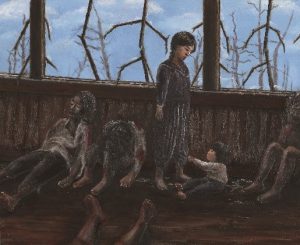 Title: “Please Look for My Mommy!” |
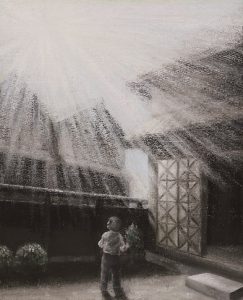 Title: “An Eerie Flash of Light” |
3.The Realities of the Atomic Bombing and Hopes for Peace
(1) Interview with Mayor of Hiroshima
Mayor has called for the abolishment of nuclear weapons as the head of an atomic-bombed city, and welcomed the G7 Summit being held in Hiroshima, saying “With the situation in Ukraine becoming more tense and concern over the risk of nuclear weapons being used, the existence of humanity itself could be at risk, and so I believe it is very meaningful for the leaders of major nations, including nuclear weapon states, to come together and hold discussions in Hiroshima.”
In this tour, the mayor will speak about the perspective of Hiroshima, as an atomic-bombed city, on the situation in Ukraine, and about the state of preparations and his expectations for the G7 summit to be held in Hiroshima this May.
(2) Interview with Atomic Bomb Survivor

[Photo courtesy of Ms. KONO Kiyomi]
As the atomic bomb survivors grow older, the time left gets shorter for us to hear the physical and emotional pain they experienced and the message that the devastation of the nuclear bombings must never be repeated. Even with their activities to communicate their experiences having been restricted due to the COVID-19 pandemic, the survivors continue to share their experiences and their desires for peace.
In this tour, we will hear from atomic bomb survivor Ms. KONO Kiyomi about the bombing and her message today to the world and younger generations about peace and the abolishment of nuclear weapons.
(3) Hiroshima Peace Memorial Museum
The Hiroshima Peace Memorial Museum collects and exhibits personal belongings of the victims of the bombing, with pictures and other materials showing the horrors of the bombing, the history of Hiroshima before and after the bombing, and the history of the Nuclear Age. Based on the theme of “the realities of the atomic bombing,” the exhibits at the Main Building explain what happened in Hiroshima on August 6, 1945 and tell the suffering and sadness which atomic bomb victims and their families have dealt with to this day. In the East Building, there is a White Panorama that projects images of Hiroshima before and after the bombing onto a 3D model, as well as explanations of the international situation surrounding nuclear weapons and Hiroshima’s reconstruction after the war, and video booth with testimonies by atomic bomb survivors.
In this tour, after a briefing by museum staff, participants are free to look around the museum by themselves.
4.G7 Summit Venue: Grand Prince Hotel Hiroshima
The Grand Prince Hotel Hiroshima, which will be the venue for the G7 Summit, faces the Seto Inland Sea, and is located only seven kilometers from the center of Hiroshima City, on Ujina Island in Minami Ward. This hotel was also used for the G7 Foreign Ministers’ Meeting held ahead of the 2016 Ise-Shima Summit.
This tour will spend the night at Grand Prince Hotel Hiroshima.
[Tour Itinerary]
1. Dates
Tuesday, 25 April to Wednesday, 26 April, 2023
2. Schedule
[Tuesday, 25 April]
8:20-9:50 Haneda Airport-Hiroshima Airport (ANA673)
11:10-12:10 Orizuru Tower/Companies in Hiroshima Prefecture
12:30-13:50 Ganso Henkutsuya (including lunch)
14:10-15:40 Interview with Atomic Bomb Survivor
16:10-17:00 Interview with Mayor of Hiroshima
17:10-18:00 Hiroshima Peace Memorial Museum
18:30 Grand Prince Hotel Hiroshima
[Wednesday, 26 April]
7:55 Depart from hotel
8:30-10:30 Hiroshima Electric Railway Co., Ltd.
11:30-12:20 Lunch
12:50-14:30 Maruni Wood Industry
15:30-16:50 Sotoku High School Newspaper Club
17:10-18:10 Hiroshima Municipal Motomachi Senior High School Course of Creative Expression
20:25-21:40 Hiroshima Airport-Haneda Airport (JAL266)
3. Qualification: Bearer of the Ministry of Foreign Affairs of Japan Press Registration Card
4. Cost: 18,000 yen per person, including transportation, accommodation (breakfast included), and lunches (for both days).
5. Participants: Limited to 10 applicants.
(Only one reporter or one photographer from each company, but two participants from each TV team will be acceptable.)
* If there are more applicants than positions available, the tour organizer may make arrangements.
6. FPCJ Contact: Hayashi(Ms.), Takahashi(Ms.)
Media Relations Division
(Tel: 03-3501-3405, E-mail: ma@fpcjpn.or.jp)
7. Remarks:
(1) This tour is sponsored by the Citizens Council for the Hiroshima Summit, co-sponsored by the Ministry of Foreign Affairs, and run by the FPCJ.
(2) The schedule is subject to change without notice.
(3) This tour will require participants to bear a part of the cost, but is not a profit-making venture.
(4) The Citizens Council for the Hiroshima Summit, the Ministry of Foreign Affairs and the FPCJ take no responsibility for any accidents, injuries, illness, or other problems which occur during the tour.
(5) There may be some restrictions on photographing and filming at the tour sites. Please follow the instructions of the staff in charge.
(6) Please be aware that videos and photos of the tour, and articles about it, may be posted by the Citizens Council for the Hiroshima Summit, the Ministry of Foreign Affairs and the FPCJ on their websites or social media.



